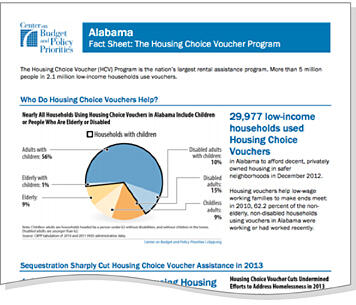off the charts
POLICY INSIGHT
BEYOND THE NUMBERS
BEYOND THE NUMBERS
A key question for next fiscal year is whether policymakers will adequately fund the Housing Choice Voucher Program, which helps more than 2 million low-income families rent modest units of their choice in the private market but has been hit hard by the sequestration budget cuts. Some 70,000 fewer families have vouchers than a year ago. To show what’s at stake, we’ve prepared state-by-state fact sheets on the impact of vouchers and the sequestration cuts.
Image

We’ve also issued a report reviewing research findings on vouchers’ impact on poor and vulnerable households. In brief, studies show that vouchers:
- Reduce crowding, housing instability, and homelessness. Low-income families with children that received vouchers are much less likely than families without vouchers to be homeless or doubled up with friends and family, to live in crowded conditions, or to move frequently.
- Reduce poverty. Vouchers and other rental assistance lifted 2.8 million people — including 1 million children — above the poverty line in 2012 under the federal government’s Supplemental Poverty Measure, which counts non-cash benefits. Vouchers alone likely produced at least half of that effect.
- Help low-wage workers make ends meet. About two-thirds of voucher holders who aren’t elderly or disabled either work or worked recently. Vouchers are critical to enabling low-income working families to make ends meet. For a mother of two renting an apartment for $700 and working 30 hours a week at the minimum wage, a voucher is worth about $440 a month.
- Give families access to neighborhoods with better opportunities. By allowing families to rent a unit of their choice in the private market, vouchers enable them to move to safer neighborhoods. A growing body of evidence indicates that growing up in neighborhoods of concentrated poverty can adversely affect children’s health, education, and long-term economic prospects.
- Reduce costs in health care and other public services. In addition to improving the lives of vulnerable low-income people, vouchers and other rental assistance can produce savings in other program areas that offset part (in some circumstances all) of the cost of the rental assistance. For example, rental assistance combined with supportive services for homeless people with serious health problems can achieve savings in the health care, corrections, and emergency shelter systems that are close to or above the cost of the rental assistance and services.
Topics:
Stay up to date
Receive the latest news and reports from the Center
